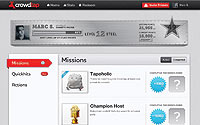Commentary
Crowdtap: Getting More From Brand Ambassadors
- by John Capone , March 2, 2012
 Beyond accumulating “likes,” what can brands do to reach and interact with consumers? So-called “brand-to-fan” connector and influencer marketing
start-up Crowdtap has got a few ideas. We all know that social media marketing presents vast opportunities beyond a few Facebook tabs and retweeted sweepstakes entries. But since it came out of beta
in March 2011, Crowdtap has helped the likes of Old Navy, Adidas and Microsoft connect with, learn from, and reach influencers and their networks.
Beyond accumulating “likes,” what can brands do to reach and interact with consumers? So-called “brand-to-fan” connector and influencer marketing
start-up Crowdtap has got a few ideas. We all know that social media marketing presents vast opportunities beyond a few Facebook tabs and retweeted sweepstakes entries. But since it came out of beta
in March 2011, Crowdtap has helped the likes of Old Navy, Adidas and Microsoft connect with, learn from, and reach influencers and their networks.
“How do we scale this and make
this a platform any brand can use?” Crowdtap founder and CEO Brandon Evans asked when forming the company. The first step was aggregating the audience that would put the crowd in the
company’s name. Anyone can sign up for Crowdtap, and they do so for the usual reasons: access to offers, promotions and to communicate with others. The Crowdtap community is also a quick and
powerful tool for creating insight panels and instant focus groups. But that’s really only the beginning.
The platform shines in its ability to identify and activate influencers,
the people who are going to reach and affect the most people, both online and off. One of the reasons this works is that the system functions best with people who want to be influencers and are good
at it. Take the Old Navy Style Council: As the name implies, it’s a group of people who want to not merely engage with the brand, but also to engage with others about the brand.
Evans next asked, “We have all these members; how do we activate them?”
For starters, Crowdtap instituted what Evans calls an “earn up” model: By taking social
actions, people can earn achievement badges and the like within the system. These actions can be a simple Web share of a brand’s news or promotion on Facebook or Twitter, or answering or sharing
a quick poll question about a brand or product; or they can be something as complicated as making a blog post. These achievement badges are just one of the ways Crowdtap identifies influencers.
Crowdtap also uses monitoring systems, such as a powerful, but clear and simple client dashboard to keep tabs on what happens once, for instance, an offer has left the stable, as well as to
further identify key influencers. Social interactions, such as those on Facebook, are aggregated and counted, and blogs written by members are tabulated, tracked and linked to. So while algorithms and
data are bubbling up, a person can also quickly look through the various blog posts and identify the most well-done and the most effective.
“We’re not creating a destination,
but an action-based system,” explains Evans. When a brand wants to engage with its influential consumers it doesn’t send them to a Web site, but initiates an action. Then it lets the
influencers do what they do best. It’s an honest exchange that works for everyone.
By identifying consumers willing and able to be brand ambassadors, Crowdtap has harnessed the
power of the network effect in the real world. Crowdtap also gives consumers who want them, the means, tools and materials to host brand events (both virtual and real). One way the online interactions
turn into real-world momentum is through social sampling, in which samples are sent to influencers, who can then identify others to whom samples should be sent. Influencers also have the opportunity
to host brand events at their homes and hand out samples there.
Finally, influencers host in-store shopping events, such as a nationwide series hosted by the Old Navy Style Council. Not
only are Crowdtap community members acting on a brand’s behalf, but they are also bringing their friends. Lots of them.
So while it’s all well and good to collect Facebook
likes, Twitter followers and retweets, Pinterest pins and Tumblr reblogs, says Evans, “we’re closing the loop on all that activity.”


